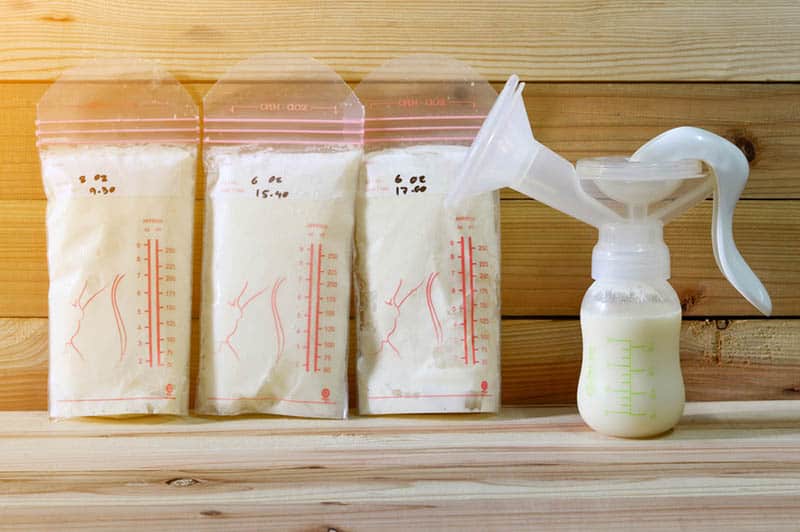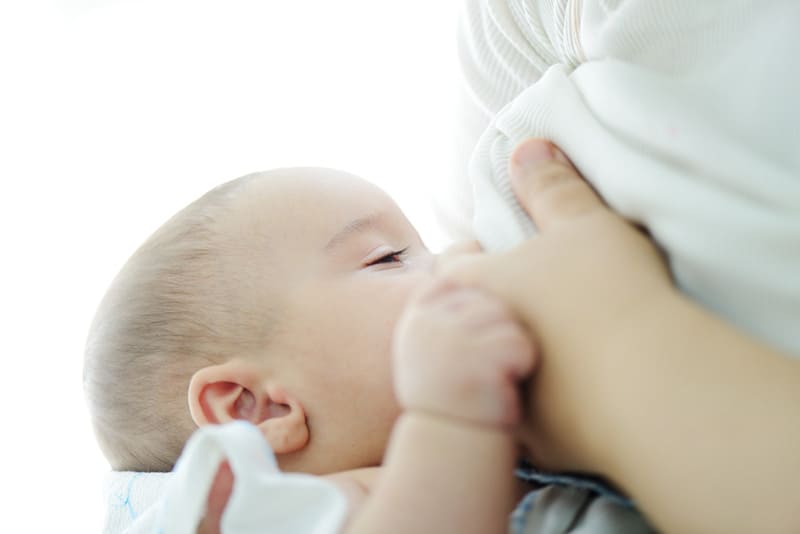Most people are born with asymmetrical facial features or asymmetry elsewhere on the body.
Just like an asymmetrical face, one breast producing less milk than the other during the nursing period is quite a common occurrence and doesn’t impose any health risks for the mother or the baby.
There are several ways to fix asymmetrical breasts or “wake up” the lazy boob, including extended pumping sessions or frequent nursing.
This condition of uneven milk production is called a slacker boob.
This is a frequent problem among breastfeeding moms that doesn’t have any negative effect on the child.
Even though it’s unnoticeable in most cases, there are some mamas who are bothered by the visible asymmetry and would like to find a way to resolve it.
A lopsided breast may occur for various reasons, from babies who prefer one breast more than the other to mamas who have one physically smaller breast which may produce less milk.
Why Is One Breast Producing Less Milk?

Almost every breastfeeding mom has noticed a lower milk supply from one breast at some point and a visible asymmetry between the left and the right side.
Some mamas (more than you could imagine) find they are producing more milk in one breast than the other.
Human bodies are asymmetrical in nature (size of feet, legs, arms, fingers, etc.).
It’s not an illness or a disorder and it doesn’t pose any risk to a person’s wellbeing.
A slacker boob is also a completely natural and normal physical occurrence that doesn’t have any serious impact on a woman’s health.
A lot of nursing mamas notice the usual symptoms of the slacker boob during the nursing period, such as the lack of milk, slower milk flow, or lower pumping output.
It’s no surprise that these experiences result in fears and anxiety especially among new moms who haven’t heard about this occurrence before.
No need to fear though, as I’ve already mentioned, a slacker boob doesn’t impose a big health risk even when it’s caused by mastitis (which should be treated from the appearance of the first symptoms).
Here are some of the most common reasons for one breast producing less milk than the other.
1. Mastitis

One of the things that scares most mamas is mastitis, the arch-nemesis of every nursing boob.
It’s a breast infection that causes swollen and painful glandular tissue.
Mastitis is a common, but very unpleasant, infection that occurs during the breastfeeding period.
It may cause flu-like symptoms, including a swollen breast and high temperature.
This infection might occur at any moment during the breastfeeding period, but the risk is at the highest level during the first six weeks postpartum.
The most common cause of mastitis is breast milk getting clogged in the milk ducts which prevents the milk flow.
Bad bacteria may end up trapped in one of the clogged milk ducts and lead to an infection.
RELATED: Sunflower Lecithin Breastfeeding Supplements For Plugged Ducts
But, germs might be coming in from the outside as well!
Unfortunately, these little pests find their way from the surface of your skin or baby’s mouth into your milk ducts.
All they need is a little crack on mom’s nipple to enter and cause havoc.
Mastitis is not a serious illness, but it’s not a joke either.
It should be treated from the first sign of symptoms to avoid great pain and low milk supply in that breast.
Reasons that might cause this infection are:
Poor latching
If a baby can’t latch properly, he can’t drain the milk ducts and, as you can guess, the ducts end up clogged.
Poor latching is usually caused because of the flat shape of the nipple or an uncomfortable nursing position.
Try to find the best position for both of you. If you see your little one struggling while trying to nurse, you’ll have to change the position until you find one that allows him to breastfeed without any problems.
Tight bra

This is not an issue exclusively related to pregnancy or breastfeeding.
Tight-fitting bras prevent nipples from breathing and it may cause skin infections, or in this case tissue infections.
Instead of pressing the nipples flat and causing clogs, getting a breathable and comfortable bra certainly sounds like a better idea!
Long time between nursing or pumping sessions
This is a very common issue among mamas who have a lower breast milk supply.
If a breastfeeding mama skips the usual time for feeding, she might end up with a clogged duct. Just because it seems like there’s no milk in the breast doesn’t mean there’s actually no milk.
Drain the breast with a lower milk supply during every nursing or pumping session.
Also, if your baby’s not hungry at the time your breasts are full, use your electric or manual breast pump and store the extra milk in storage containers for breast milk.
Cracked nipples
Sore nipples and cracks are very painful and they could lead to mastitis as the bacteria enters the breast through any sores.
Cracks should be treated in time with nipple creams for nursing in order to prevent an infection.
Past infections
Once mastitis, always mastitis!
Well, not always, but unfortunately the infection may happen more often to mamas who have had it in the past.
2. Physical difference between breasts

Another reason for lower breast milk production might just be the breast size.
As discussed earlier, many women have asymmetrical or lopsided breasts which are perfectly normal.
The bigger boob has more milk-making ducts which results in better milk production.
For some reason, the left side usually has more ducts than the right one, but it can also be the other way around.
Is there any solution?
There are a few possible solutions for better milk production, but it probably won’t have any influence on the look of the breast (they won’t magically become even).
The first and most natural way of producing more milk is putting the baby on the side that produces less during the nursing session as often as possible.
The baby will nurse strongly at the beginning which will encourage a better supply of breast milk (supply and demand system).
Frequent nursing will increase milk supply with time.
However, don’t forget about the other breast or else you could end up with mastitis.
Power pumping is another possible solution.
The point of this type of pumping is repeating the action as often as possible to even out the milk supply.
3. Baby prefers one side more than other

You might not have noticed that your little one prefers one side more than the other, but it’s very possible.
I remember my baby always turned to the other side during nursing sessions and ended up rolling on the bed at least ten times.
However, I didn’t notice this in the beginning.
I would usually just lay down or turn him to his preferred side – that was until I learned more about plagiocephaly (flat head syndrome).
Spending time on one side only may have more serious consequences than uneven milk supply like the flat head syndrome mentioned above.
But, if the baby suddenly refuses to lie on one side, it could be a sign of an ear infection.
If your little one cries every time you put him on the less preferred side, it’s an alarm to visit the doctor for medical advice.
Alternating breasts is crucial for the healthy development of the baby and for the improvement of milk supply on both sides.
4. Mama prefers one side more than other
It may sound funny at first but consciously or not, moms also choose a favorite side for nursing.
I did the same during the first few weeks of breastfeeding by forcing the right breast more than the left one until I realized all the consequences of such actions.
The only solution, in this case, is to pay attention to the side alternation.
You can make a note to alternate sides in your schedule for pumping or nursing in case you go for the same side subconsciously.
5. Breast trauma from the past
Unfortunately, women who undergo breast surgery of any kind might have more problems with breastfeeding in the future.
Breast surgery may have a negative impact on the nerve supply and breast tissue, which causes fewer stimuli for letdown and production of milk.
However, this doesn’t mean that new moms who underwent breast surgeries and want to breastfeed won’t be able to do so.
They may not have enough breast milk in the beginning but will have enough to feed their bundles of joy.
How Can I Improve Milk Production From The Slacker Boob?

The simplest way of improving the milk production in the affected breast is by establishing the supply and demand system.
If you nurse more from the affected breast, over time the supply might even out.
However, this system, even though it’s great, might not be enough for a satisfying amount of milk.
Fortunately, there are other ways that have been proven to be successful which might solve your issue as well.
1. Breast compressions
Breast compressions are essential for breastfeeding moms because they get the most out of each pumping session.
However, compressions and massages also help with an increase of milk supply over time as they drain milk ducts and send stimuli for more milk.
How do breast compressions work?
All you need to do is to form a C letter shape with your hand and then gently press the top of the breast with the thumb.
The best way to drain the ducts is to do a pulsating pattern of pressing that will give the most results.
How to do a breast massage?
For the record, squeezing the one breast producing less milk doesn’t count as a massage.
Breast massage requires a certain pattern to show satisfying results.
This means you’ll have to use your index and middle fingers together and move the fingers in circles from the top of the breast to the areola.
Repeat the movement from one side of the breast to the other, until you cover the whole area.
2. Pumping

If you notice there’s not enough milk after pumping, you’ll know which one is the lazy boob.
However, you shouldn’t let her hang there without doing anything!
Pump the lazy boob first during the pumping session and move on to the other one.
When you finish with it, go back to the slacker boob and pump it for a few more minutes again.
This will stimulate the nerves and tissue until it starts producing more milk.
3. Slacker boob needs extra work
A slacker boob might never give the same amount of milk as the preferred breast if you don’t nurse from it more.
Therefore, the lazy boob should be pumped at least once between nursing or pumping sessions.
You can add an extra session to the nursing or pumping schedule for the right or left breast, depending on which one has low milk production.
It may require more time than other methods, but it might be the most successful one as well.
Of course, one of the solutions is to visit a lactation consultant who will give you proper medical advice in case nothing else works.
4. Use the slacker boob as a pacifier!
You can actually use the slacker breast as an alternative to the pacifier.
Find the best nursing position for you and your little one before bedtime and offer him the lazy breast as a pacifier until he falls asleep.
This option will benefit both you and your munchkin!
Do I Have To Fix One Breast Producing Less Milk?

Absolutely not. If you’re not bothered by it, there’s no need to fix anything.
The slacker breast produces milk as well, just in lower quantities than the preferred one.
A lazy boob may annoy your little one from time to time, but it won’t cause any health issues to you or your baby.
My breasts were uneven at one point, but I thought it was funny and I laughed every time I saw them.
However, no one else even noticed, although I thought they looked like a watermelon and a lemon!
Many mamas are concerned that their babies won’t get enough milk by nursing from the lazy boob.
But, there’s no need to fear because the baby always gets enough nutrients if he’s breastfed as often as he wishes to.
If you use the slacker boob as well, you may use it first and then switch to the preferred breast that has more than enough milk supply for one session.
If your baby completely refuses the lazy breast, you’ll have to pump it just to keep a minimum of milk in it at least, unless you’re weaning him off breastfeeding.
Additional tip: avoid using the cold turkey method to stop breastfeeding as it might cause mastitis as well.
Final Words

Breastfeeding is one of the most beautiful experiences for every mom and the most beneficial way of providing the essentials to the baby.
However, it can also be a very stressful period, especially for new moms who haven’t had any previous experience.
In theory, breastfeeding is simple and all it takes is your little one latching to the boob and draining all the milk from it!
However, things can be a bit more complicated, just like this article shows.
One of the most frequent “problems” during breastfeeding is one breast producing less milk than the other.
Although a slacker boob may frustrate mamas who are trying to nurse their babies from both sides equally, it doesn’t pose any danger or damage to mama’s health.
One breast can produce more than enough milk for one nursing session.
Weight gain is one of the most important factors that indicates whether or not the baby is getting enough milk.
If your baby gains enough weight, there’s no need to fear that he’s not getting enough nutrients from your breast milk.
By following these tips, you may increase the production of breast milk from the slacker boob.
However, it’s not a must.
If you’re not bothered by one breast producing less milk, there’s no need to intervene.
But, if the asymmetrical breasts during the breastfeeding period frustrate you, there are high-quality breast pads that might save the day!
A few pads will even out the outside look of the breasts and will make you feel more comfortable.
You can find them on online shopping sites such as Amazon.
If that doesn’t work well for you, you can always ask an IBCLC (International Board-Certified Lactation Consultant) for expert advice.
Until next time, mamas!
Like this post? Please share or pin it for later. You can also stay in the loop and follow us on Facebook, Instagram or Pinterest.

We love honesty! Find Your Mom Tribe is an Amazon Associate and we earn from qualifying purchases through affiliate links at no extra cost to you. Please see our full Amazon Affiliate disclosure for more information.

